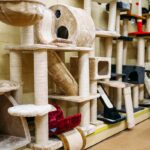Have you ever looked at a horse’s feet and wondered, Why do they wear those metal shoes? You’re not alone. Horseshoes have been a hallmark of horse care for centuries, yet many horse owners and enthusiasts still have questions about whether shoes are necessary, how they work, and how often they need to be replaced. In this guide, we’ll explore everything you need to know about horseshoes—no fluff, just practical, detailed information you can use.
The Tradition and Purpose of Horseshoes
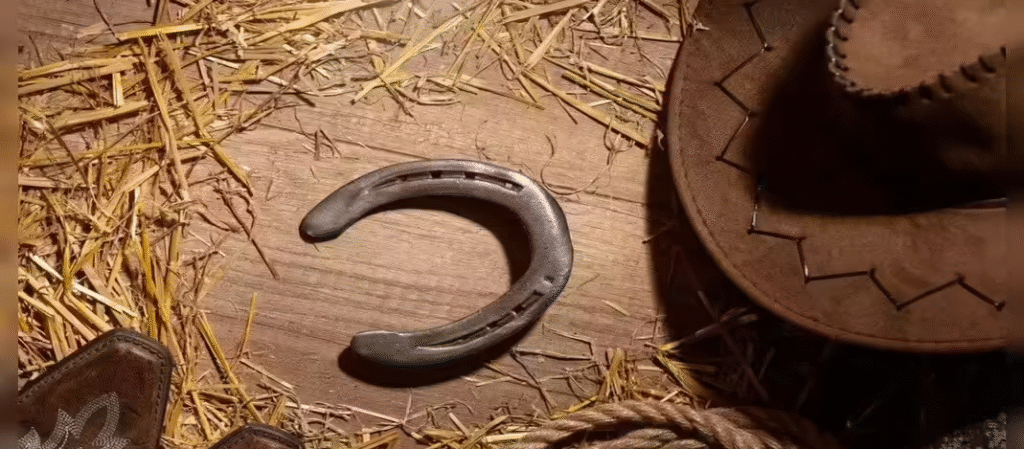
Horseshoes date back to ancient Rome, where leather hoof coverings were first used to protect horses’ feet on rough roads. As metalworking advanced, iron shoes became the norm. Today, farriers have refined the craft into a science and an art, creating shoes that protect, correct, and enhance a horse’s performance. But despite all our advances, the purpose remains the same: to protect the hoof from wear and damage.
Why This Topic Matters to Horse Owners
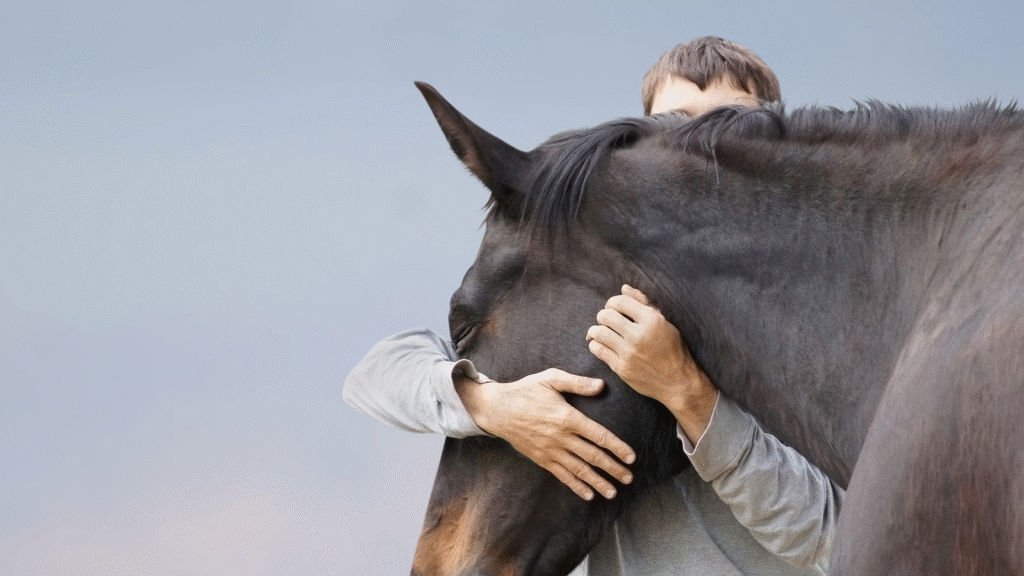
Shoeing a horse isn’t just a box to tick off your care checklist—it affects your horse’s comfort, soundness, and ability to perform. Whether you have a high-level jumper, a trail companion, or a pasture pet, understanding hoof care can prevent injuries and save you expensive vet bills down the line.
Do Horses Really Need Shoes?
It’s one of the biggest debates in equine care: barefoot vs. shod. Not every horse needs shoes, and in some cases, shoes can even do more harm than good. The decision depends on your horse’s lifestyle, workload, health, and environment.
Natural Hooves vs. Shoed Hooves
Wild horses cover up to 20 miles per day across diverse terrain. This natural movement and constant wear help keep their hooves strong and well-shaped without shoes. Domestic horses, however, don’t get that same hoof conditioning. They often work on abrasive surfaces like pavement or are confined to soft pastures that don’t wear down their hooves properly.
Shoed hooves provide consistent protection in conditions where the hoof alone can’t cope. Think of it like hiking boots vs. going barefoot on gravel—sometimes, your feet need that extra layer.
Factors That Determine the Need for Shoes
Terrain
Hard, rocky, or uneven surfaces can bruise and wear hooves faster than they grow. Horses working on pavement, gravel, or frozen ground are prime candidates for shoes.
Workload
High-impact sports—jumping, eventing, barrel racing—create stresses on the hoof wall and sole that shoes help mitigate.
Hoof Health
Horses with thin soles, flat feet, chronic laminitis, or conformation issues often require shoes for extra support and protection.
Why Do Horses Wear Horseshoes?
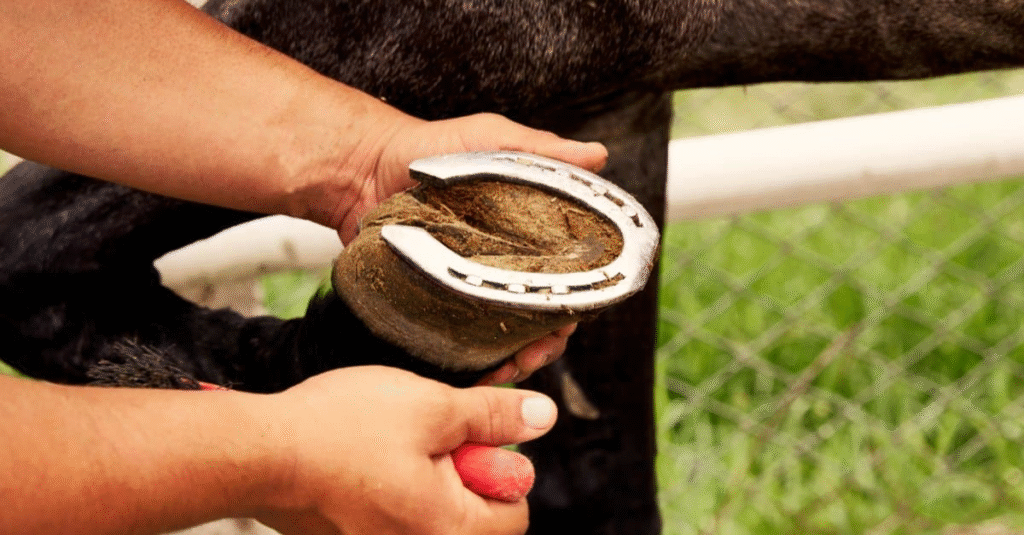
There are several practical reasons horses wear shoes beyond simply protecting the hoof.
Protecting the Hoof
The most obvious reason is to prevent excessive wear and damage. Horseshoes absorb impact and shield the sole from bruising and cracking.
Enhancing Performance
Specially designed shoes improve traction, especially on wet grass or hard-packed surfaces. For racehorses, lightweight aluminum shoes can reduce fatigue and increase speed.
Correcting Gait and Hoof Problems
Therapeutic shoes can redistribute weight, encourage proper hoof growth, or correct an abnormal gait. For example, wedge shoes can help horses with heel pain by elevating the hoof angle.
The Anatomy of a Horseshoe
Not all horseshoes are the same. They vary in material, size, and purpose.
Materials Used in Horseshoes
Steel: The most common, durable, and heavy-duty. Best for working horses on rough terrain.
Aluminum: Lightweight and commonly used in racing or performance horses.
Rubber or Plastic: Occasionally used for cushioning or therapeutic purposes.
Different Types of Horseshoes
- Regular Flat Shoes: The all-purpose workhorse of horseshoes.
- Rim Shoes: With a groove for extra traction.
- Bar Shoes: A closed heel for extra support and stability.
- Heart Bar Shoes: Used for treating laminitis by supporting the frog.
- Glue-On Shoes: For horses with brittle hooves that can’t hold nails.
How Often Should Horses Be Shoed?

Hooves never stop growing, and shoes wear out over time. Most horses need trimming and re-shoeing every 4–6 weeks.
Standard Shoeing Intervals
Hoof growth rates depend on factors like season, nutrition, and age. In warm weather, hooves grow faster. If you let the shoes stay on too long, the hoof grows over them and changes how weight is distributed, which can lead to cracks or strain.
Signs It’s Time for New Shoes
- Nails sticking out or getting loose
- The shoe shifting or appearing twisted
- Cracks or chips in the hoof wall
- Your horse stumbling more often
What Happens If a Horse Doesn’t Wear Shoes?
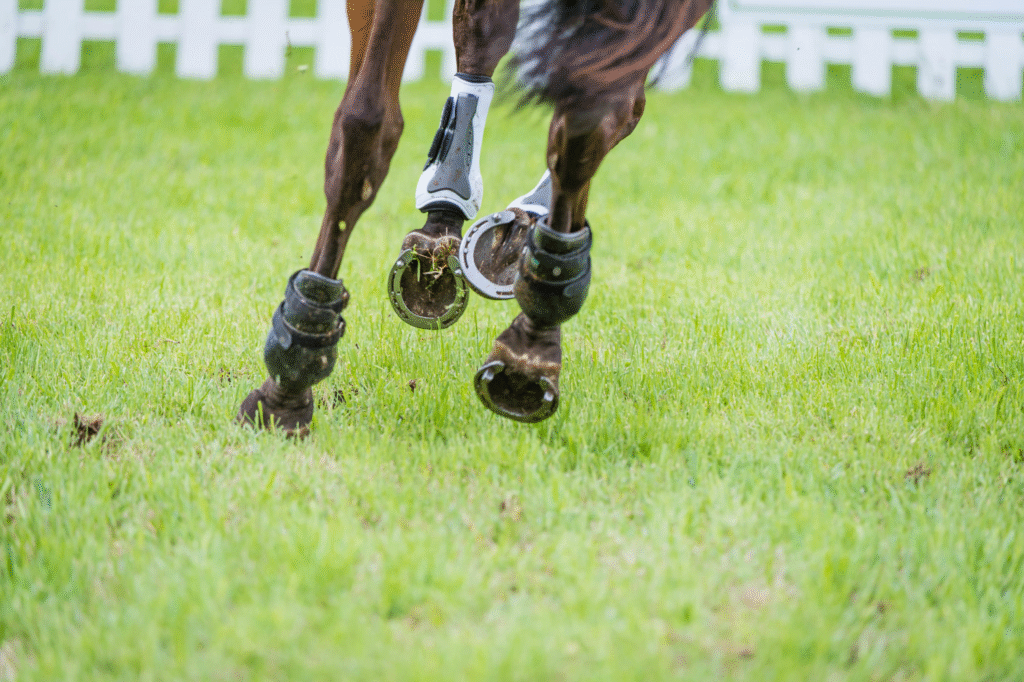
Some horses are healthier barefoot, but not all can go unshod safely.
Risks of Going Barefoot
Horses on rocky terrain can develop sole bruises, hoof cracks, or abscesses without shoes. If your horse has thin soles or weak hoof walls, going barefoot can be painful.
Benefits of Barefoot Horses
Barefoot hooves can adapt and toughen naturally. There’s also better circulation without the restriction of shoes. Many trail and pasture horses thrive barefoot with proper trimming.
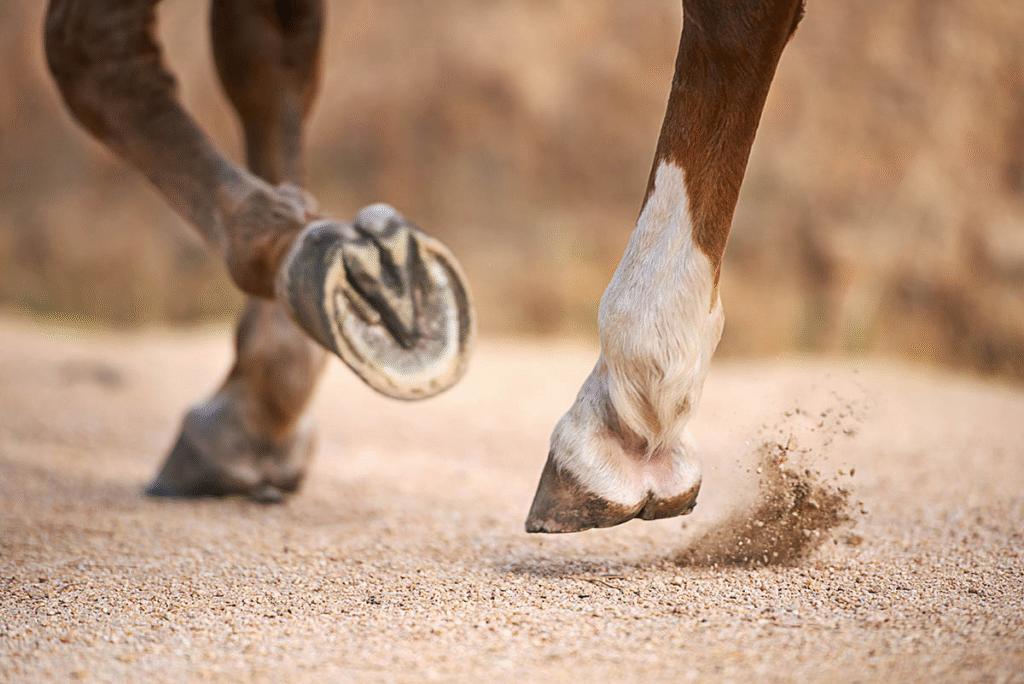
There’s no one-size-fits-all answer.
Considerations for Performance Horses
Horses doing high-impact work generally need shoes to prevent injury and improve traction. Barefoot just isn’t practical for most performance disciplines.
Considerations for Pasture Horses
Pasture horses or those lightly ridden may never need shoes. They benefit from natural hoof wear, and you save money on farrier costs.
How Are Horseshoes Applied?

Shoeing isn’t just slapping metal on a hoof—there’s a process to it.
The Role of a Farrier
Farriers are skilled craftspeople trained to balance hooves, shape shoes, and address hoof health problems.
The Shoeing Process Step by Step
- Remove Old Shoes: Farriers pry off the worn shoes with pincers.
- Trim the Hoof: Excess growth is trimmed, and the hoof is balanced.
- Shape the New Shoe: The farrier heats and bends the shoe to fit precisely.
- Nail the Shoe: Special nails are driven into the insensitive hoof wall.
- Clinch the Nails: The ends of the nails are bent and smoothed so they don’t snag.
Done correctly, your horse walks away comfortable and protected.
Do Horses Feel Pain When Shoed?
A common misconception is that nailing on a shoe hurts the horse. In reality, the hoof wall has no nerve endings—like your fingernails. When a skilled farrier works, your horse feels only pressure, not pain. If a nail goes into sensitive tissue, called “quicking,” the horse will react, and the farrier will pull and replace the nail.
Special Shoes for Special Needs
Some horses need more than standard protection.
Therapeutic Shoes
- Heart Bar Shoes: Provide frog support for laminitis.
- Egg Bar Shoes: Extend behind the hoof for heel support in navicular disease.
- Wedge Pads: Alter the hoof angle to relieve tendon strain.
Traction and Performance Shoes
Studded shoes help jumpers grip slick arenas. Raced horses often wear lighter shoes for speed.
Myths and Misconceptions About Horseshoes

Let’s bust a few persistent myths:
- Shoes are always necessary.
- Many horses are perfectly fine barefoot.
- Shoeing weakens hooves.
- Improper shoeing or neglect weakens hooves—not shoes themselves.
- Shoeing always hurts.
- Done correctly, it doesn’t hurt at all.
Caring for Your Horse’s Hooves Between Shoeing
Shoes are only part of hoof care. Daily attention keeps hooves healthy.
Daily Hoof Care
- Pick out hooves daily to remove rocks and manure.
- Check for heat, foul smells, or cracks.
- Keep hooves dry to prevent thrush.
Nutrition’s Role in Hoof Health
Good nutrition strengthens hooves. Feed balanced diets rich in:
- Biotin
- Zinc
- Methionine
- Omega-3 fatty acids
These nutrients help build a strong hoof wall.
Conclusion
Shoes protect, support, and help your horse perform their best. Whether your horse needs shoes or can go barefoot depends on their work, environment, and health. Always consult a trusted farrier and veterinarian to create a hoof care plan tailored to your horse’s unique needs.
FAQs
1. How often should I have my horse’s shoes replaced?
Most horses need re-shoeing every 4–6 weeks, but it depends on hoof growth and wear.
2. Do shoes hurt horses?
No. If applied correctly, shoes do not hurt. The hoof wall doesn’t have nerves.
3. What are therapeutic shoes?
Shoes designed to treat or manage hoof problems, like laminitis or navicular disease.
4. Can my horse go barefoot?
Possibly. Many horses can thrive barefoot if their workload and environment allow.
5. How do I know if my horse needs shoes?
Talk to your farrier and vet. They’ll assess hoof health, your horse’s workload, and your riding surface to help you decide.






